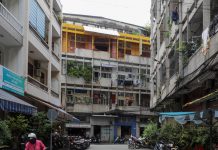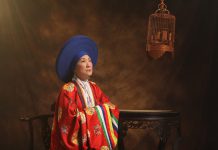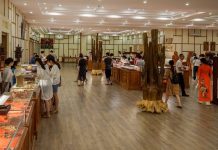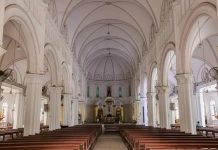Lack of funds, personnel and knowhow are preventing proper protection of Vietnam’s art treasures, conservation experts say.
The worrying lack of protection came to light recently after an extremely valuable painting suffered an estimated 30 percent damage after it was cleaned with dishwashing liquid and sandpaper by a clueless staff of the Ho Chi Minh City Fine Arts Museum.
The lacquer painting damaged was the 50-year-old Vuon Xuan Trung Nam Bac (Spring Garden Of the Central, Southern and Northern regions).
In Vietnam, objects of special cultural and historical value are recognized as national treasures and preserved by the government. So far eight paintings have received this honor, but most of them receive no special care.
The National Museum of Fine Arts, where six national treasure paintings are preserved, has no separate place for displaying and preserving these valuable art pieces. Although the six paintings have been evaluated by the National Cultural Heritage Council as national treasures, they are treated the same as other displays.
“The art pieces are of different eras and themes, so we cannot put them together in a separate display area,” Tran Dung Tien, director of the Center for Preservation and Renovation of art works at the Vietnam Fine Arts Museum, told local media.
All the displays in the museum are valuable, so preservation efforts are uniform, Tien said. The national treasures only receive a better display position, longer description of its value and better lighting conditions, he added.
But experts say valuable paintings in Vietnam do not receive standard protection and preservation efforts.
 |
A part of Vuon Xuan Trung Nam Bac, a painting that was damaged by an ill-informed cleaner. Photo by VnExpress/Mai Nhat |
Big gap
There is a big gap between preservation standard and reality in Vietnamese museums, said Vi Kien Thanh, head of the fine arts, photography and exhibition department under the Ministry of Culture, Sports and Tourism.
“I can only say that the preservation has improved, but it has not yet met what we expect,” Thanh said.
One of the few national treasures that has been properly restored is Em Thuy (Little Thuy) by Tran Van Can, which underwent a standard restoration process by a foreign expert sent to Vietnam by Asia Link, a foreign art organization, Tien told Thanh Nien newspaper.
“Preservation work in the museums is not professional at present,” said painter Uyen Huy, president of the HCMC Association of Fine Arts.
Other experts have said that museums do not have professionally qualified staff to preserve its treasures.
There is no course in art schools that offers preservation of paintings as a major. Many Vietnamese museum staff mostly learn things on their own and teach each other. In some cases, they learn from short-term training courses conducted by international experts.
Apart from the lack of professionally trained staff, Vietnamese museums also lack facilities to preserve the paintings and have to make do with limited resources.
“Since we do not buy a lot (of equipment), few sellers want to supply. We have to order from overseas,” Tien said, adding that the museums and his department were constrained in doing this.
The Vietnam National Museum of Fine Arts uses cast iron bricks to straighten paintings, while there are specific tools for the purpose in foreign countries. Hoi Chua (Pagoda Festival), a lacquer painting by Le Quoc Loc, was straightened using the bricks.
Finally, museums do not have funds to buy equipment or train staff in advanced preservation techniques.
“Every museum wants to invest more in equipment, but the key issue is that our budget is limited,” said Thanh.






























